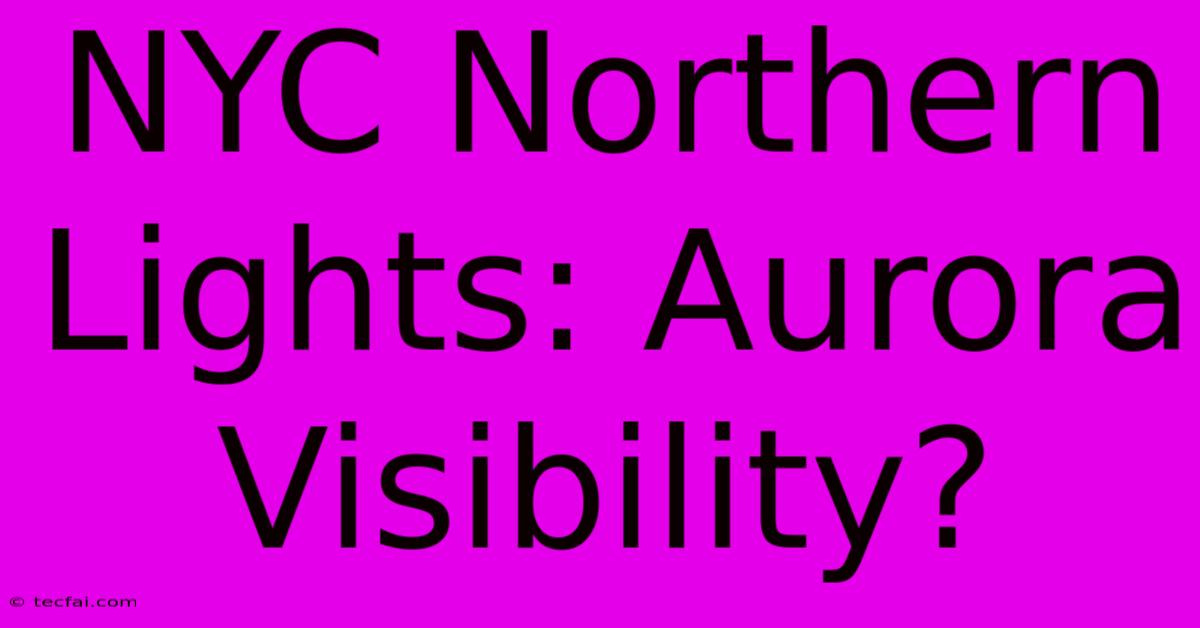NYC Northern Lights: Aurora Visibility?

Discover more detailed and exciting information on our website. Click the link below to start your adventure: Visit Best Website tecfai.com. Don't miss out!
Table of Contents
NYC Northern Lights: Aurora Visibility? A Rare Celestial Event
New York City, the city that never sleeps, might soon be witnessing a different kind of spectacle – the mesmerizing dance of the Northern Lights, also known as the Aurora Borealis. While typically associated with high-latitude regions like Alaska and Scandinavia, powerful solar storms can sometimes push the aurora further south, making a sighting in NYC a rare and exciting possibility. But just how likely is it? Let's delve into the factors influencing aurora visibility in the Big Apple.
Understanding the Aurora Borealis
The aurora is a natural light display in the sky, predominantly seen in the high-latitude regions. It's caused by charged particles from the sun interacting with the Earth's atmosphere. These particles, propelled by solar winds, follow the Earth's magnetic field lines, concentrating near the poles. The intensity and visibility of the aurora depend heavily on the strength of these solar winds – a phenomenon that is difficult to predict with complete accuracy.
Key Factors Affecting NYC Aurora Visibility:
-
Solar Flare Strength: The power of the solar flare is paramount. A significant geomagnetic storm, measured by the Kp index (a scale of geomagnetic activity), is necessary to push the aurora's oval far enough south to be visible in lower latitudes like New York City. A Kp index of 7 or higher often increases the chances, though even then, it's not guaranteed.
-
Atmospheric Conditions: A clear, dark night sky is crucial. Light pollution from the city itself is a significant hurdle. Even with a powerful aurora, the brightness of NYC might obscure the subtle glow. Furthermore, cloud cover will completely block any chance of viewing.
-
Geomagnetic Latitude: NYC is located at a relatively low geomagnetic latitude. This means the aurora oval needs to expand significantly southward to become visible. While theoretically possible, it's a less frequent occurrence compared to areas closer to the Arctic Circle.
When Might You See the Northern Lights in NYC?
Predicting aurora sightings is challenging, even for scientists. Space weather agencies like NOAA (National Oceanic and Atmospheric Administration) provide forecasts, but these are probabilities, not guarantees. Keep an eye on their space weather alerts and aurora forecasts. The best chances usually arise during periods of high solar activity, which follows a roughly 11-year cycle. However, even during these peak periods, a NYC aurora sighting remains a rare event.
Maximizing Your Chances:
-
Check Space Weather Forecasts Regularly: Stay updated on solar activity predictions. Websites and apps dedicated to aurora forecasting can provide valuable insights.
-
Find a Dark Location: Escape the city lights as much as possible. Areas outside of NYC with minimal light pollution will offer a much better viewing experience if an aurora does appear.
-
Be Patient and Persistent: Even with favorable conditions, the aurora might be faint. Give yourself ample time to observe the sky.
Is it Worth the Wait?
While witnessing the Northern Lights from NYC is a long shot, the experience would be truly unforgettable. The rarity of the event adds to its allure, transforming a potential sighting into a once-in-a-lifetime opportunity. Keep your hopes high, monitor space weather updates, and maybe, just maybe, you'll witness this incredible natural phenomenon from the heart of the Big Apple. The thrill of the chase is, in itself, a reward.
Conclusion
Seeing the Northern Lights from New York City is extremely rare but not impossible. The interplay of solar activity, atmospheric conditions, and geomagnetic latitude makes it a low-probability event. However, by understanding the factors involved and staying informed about space weather forecasts, you can improve your chances of witnessing this spectacular celestial display. So keep looking up! You might just be rewarded with an awe-inspiring view of the aurora borealis over the NYC skyline.

Thank you for visiting our website wich cover about NYC Northern Lights: Aurora Visibility?. We hope the information provided has been useful to you. Feel free to contact us if you have any questions or need further assistance. See you next time and dont miss to bookmark.
Featured Posts
-
Betting Claim Coote Faces Fa
Nov 28, 2024
-
Efl Derby Vs Swansea Goals And Highlights 1 2
Nov 28, 2024
-
Publix Walmart And More Sc Grocers
Nov 28, 2024
-
Mishal Husain Leaving Bbc News
Nov 28, 2024
-
Smyths Toys Reports E2 49bn Revenue
Nov 28, 2024
